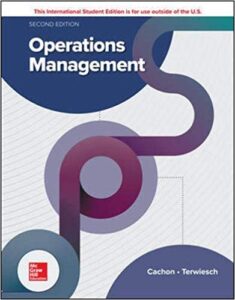Description
Test Bank For Operations Management 2nd Edition By Gerard Cachon
Chapter 6 Learning Curves
1) All learning curves have an exponential growth trajectory.
Answer: FALSE
Explanation: There are at least three forms of learning curves: exponential growth, exponential decay, and diminishing return growth.
Difficulty: 1 Easy
Topic: Various Forms of the Learning Curve
Learning Objective: 06-01 Distinguish between various shapes of learning curves.
Bloom’s: Remember
AACSB: Analytical Thinking
Accessibility: Keyboard Navigation; Screen Reader Compatible
2) The power law assumes a constant percentage improvement with each doubling of cumulative experience.
Answer: TRUE
Explanation: The power law assumes performance improves by a fixed percentage with each doubling of cumulative experience.
Difficulty: 1 Easy
Topic: The Power Law
Learning Objective: 06-02 Determine the unit cost of a process given a learning rate and an experience level.
Bloom’s: Remember
AACSB: Analytical Thinking
Accessibility: Keyboard Navigation; Screen Reader Compatible
3) A log-log plot of a learning curve that follows the power law shows a non-linear decrease as a curve.
Answer: FALSE
Explanation: A log-log plot of a learning curve that follows the power law shows a non-linear decrease as a straight line.
Difficulty: 1 Easy
Topic: Estimating the Learning Curve Using a Linear Log-Log Graph
Learning Objective: 06-03 Estimate the learning rate using past cost data.
Bloom’s: Remember
AACSB: Analytical Thinking
Accessibility: Keyboard Navigation; Screen Reader Compatible
4) For volumes greater than one, the cumulative learning curve coefficients are always bigger than the learning curve coefficients.
Answer: TRUE
Explanation: Both coefficients are equal to one for the first unit independent of learning rates. After this, the cumulative coefficients are bigger.
Difficulty: 2 Medium
Topic: Using Learning Curve Coefficients to Predict Cumulative Costs
Learning Objective: 06-05 Predict cumulative cost using the LCC method.
Bloom’s: Understand
AACSB: Analytical Thinking
Accessibility: Keyboard Navigation; Screen Reader Compatible
5) Average tenure is the average time an employee spends with a company before leaving.
Answer: FALSE
Explanation: Average tenure is the average time an employee has spent on his or her job. It is half the average time employees spend with the company.
Difficulty: 2 Medium
Topic: Employee Turnover and Its Effect on Learning
Learning Objective: 06-06 Determine employee turnover and average tenure.
Bloom’s: Understand
AACSB: Analytical Thinking
Accessibility: Keyboard Navigation; Screen Reader Compatible
6) Standardization does not apply to service settings because of the high variability in processing times.
Answer: FALSE
Explanation: There are three elements to standardization: processing time, work sequence, and inventory. Work sequence can be standardized in service settings.
Difficulty: 1 Easy
Topic: Standardization as a Way to Avoid Relearning
Learning Objective: 06-07 Understand the benefits of documentation and standardization.
Bloom’s: Remember
AACSB: Analytical Thinking
Accessibility: Keyboard Navigation; Screen Reader Compatible
7) The most common form of learning curves uses all of these measures of performance to plot against process experience EXCEPT ________.
A) labor content
B) unit cost
C) processing time
D) interest rate
Answer: D
Explanation: Interest rate is set by the financial market and is independent of the experience of a process.
Difficulty: 1 Easy
Topic: Various Forms of the Learning Curve
Learning Objective: 06-01 Distinguish between various shapes of learning curves.
Bloom’s: Remember
AACSB: Analytical Thinking
Accessibility: Keyboard Navigation; Screen Reader Compatible
8) Which of the following learning curves captures the relationship between the percentage of defects (y-axis) and the number of times an operation is performed (x-axis)?
A)
B)
C)
D)
Answer: A
Explanation: The number of defects decreases and levels off to zero with cumulative experience.
Difficulty: 1 Easy
Topic: Various Forms of the Learning Curve
Learning Objective: 06-01 Distinguish between various shapes of learning curves.
Bloom’s: Remember
AACSB: Analytical Thinking
Accessibility: Keyboard Navigation
9) A(n) ________ learning curve is indicative of a positive relationship between the experience with a process and its performance measure such as production yield or customer satisfaction score.
A) downward-sloping
B) upward-sloping
C) flat
D) bell-shaped
Answer: B
Explanation: As experience with a process increases, so does performance. A higher production yield or customer satisfaction score is indicative of better performance. Therefore, the relationship between the two is positive, resulting in an upward-sloping learning curve.
Difficulty: 1 Easy
Topic: Various Forms of the Learning Curve
Learning Objective: 06-01 Distinguish between various shapes of learning curves.
Bloom’s: Remember
AACSB: Analytical Thinking
Accessibility: Keyboard Navigation; Screen Reader Compatible
10) A(n) ________ learning curve is indicative of a negative relationship between the experience with the process and its performance measure such as processing time or number of defects.
A) downward-sloping
B) upward-sloping
C) flat
D) bell-shaped
Answer: A
Explanation: As experience with a process increases, so does performance. A lower processing time or number of defects is indicative of better performance. Therefore, the relationship between the two is negative, resulting in a downward-sloping learning curve.
Difficulty: 1 Easy
Topic: Various Forms of the Learning Curve
Learning Objective: 06-01 Distinguish between various shapes of learning curves.
Bloom’s: Remember
AACSB: Analytical Thinking
Accessibility: Keyboard Navigation; Screen Reader Compatible

Reviews
There are no reviews yet.